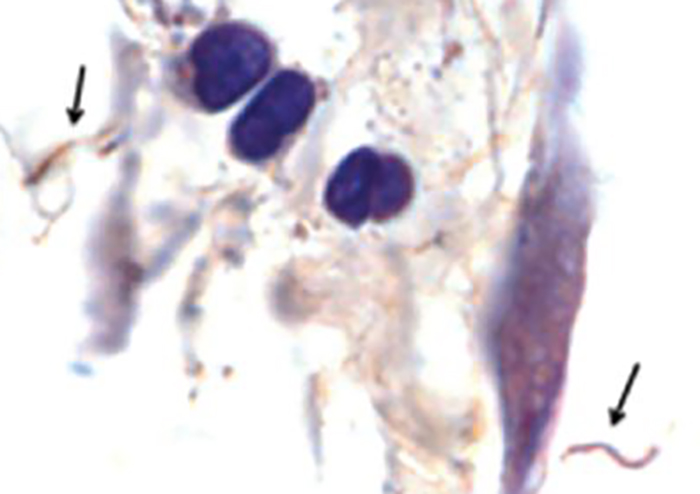Nedergaard describes the glymphatic system as like a dishwasher for the brain. "The brain is very active," she says, "and so it produces a lot of junk that needs to be cleaned out."
In hindsight, she says, the system should have been noticed long ago. When the skull and head are dissected, the vessels are visible to the naked eye. But no one bothered to really look: "Usually the brain is seen only as a bunch of nerve cells. We have come to think of the brain as a computer. And it's not. It's a living organ."
Nedergaard and Helene Benveniste, a scientist at Yale University, have found evidence linking problems in the lymphatic and glymphatic systems to Alzheimer's. In a study on mice, they showed that glymphatic dysfunction contributes to the buildup in the brain of amyloid beta, a protein that plays a key role in the disease.
Last year, Jeff Iliff, a neuroscientist at Oregon Health & Science University, and several colleagues examined postmortem tissue from 79 human brains. They focused on aquaporin-4, a key protein in glymphatic vessels. In the brains of people with Alzheimer's, this protein was jumbled; in those without the disease, the protein was well organized. This suggests that glymphatic breakdowns may play a role in the disease, Iliff says.
The vessels have also been implicated in autoimmune disease. Researchers knew that the immune system has limited access to the brain. But at the same time, the immune system kept tabs on the brain's status; no one knew exactly how. Some researchers theorize that the glymphatic system could be the conduit and that in diseases such as multiple sclerosis — where the body's immune system attacks certain brain cells — the communication may go awry.
The system may also play a role in symptoms of traumatic brain injury. Nedergaard has shown that in mice, the injuries can produce lasting damage to the glymphatic vessels, which are quite fragile. Mice are a good model, she says, because their glymphatic systems are very similar to humans'. She and Iliff found that even months after being injured, the animals' brains were still not clearing waste efficiently, leading to a buildup of toxic compounds, including amyloid beta. Nedergaard returns to the dishwasher analogy. "It's like if you only use a third of the water when you turn on the machine," she says. "You won't get clean dishes."
Recent research has also found evidence that the glymphatic system may extend into the eye. For decades, scientists have noted that many people with Alzheimer's disease also have glaucoma, in which damage to the optic nerve causes vision loss. But they struggled to find a common mechanism; the glymphatic system may be the link.
In January, Belgian and Swiss researchers identified a rich network of glymphatic vessels within the optic nerve. The scientists also found that when these vessels malfunction, they seem to leave behind deposits of amyloid beta as well as other neurotoxins that damage the optic nerve.
And in March, Harvard University researchers reported that glymphatic flow is significantly decreased in the period just before a migraine. The intense pain in these headaches is caused largely by inflamed nerves in the tissue that surrounds the brain. Neuroscientists Rami Burstein and Aaron Schain, the lead authors, theorize that faulty clearance of molecular waste from the brain could trigger inflammation in these pain fibers.
One key to glymphatic performance seems to be sleep. Nedergaard has shown that at least in mice, the system processes twice as much fluid during sleep as it does during wakefulness. She and her colleagues focused on amyloid beta; they found that the lymphatic system removed much more of the protein when the animals were asleep than when they were awake. She suggests that over time, sleep dysfunction may contribute to Alzheimer's and perhaps other brain illnesses. "You only clean your brain when you're sleeping," she says. "This is probably an important reason that we sleep. You need time off from consciousness to do the housekeeping."
Nedergaard and Benveniste have also found that sleep position is crucial. In an upright position — someone who is sitting or standing — waste is removed much less efficiently. Sleeping on your stomach is also not very effective; sleeping on your back is somewhat better, while lying on your side appears to produce the best results. The reason for these differences remains unclear, but Nedergaard suspects that it is probably related to the mechanical engineering of the lymphatic vessels and valves; she suggests that the healthiest approach may be to move periodically while you sleep.
Sleep is probably not the only way to improve glymphatic flow. For instance, a paper published in January by Chinese researchers reported that in mice, omega-3 fatty acidsimproved glymphatic functioning.
Benveniste is examining dexmedetomidine, an anesthetic that may have the ability to improve glymphatic flow. And in a small human study, other scientists have found that deep breathing significantly increases the glymphatic transport of cerebrospinal fluid into the brain.
Alitalo is experimenting with growth factors, compounds that can foster regrowth of the vessels in and around the brain. He has used this method to repair lymphatic vessels in pigs and is now testing the approach in the brains of mice that have a version of Alzheimer's.
"Right now there are no clinical therapies in this area," he says. "But give it a little time. This has only just been discovered."





















